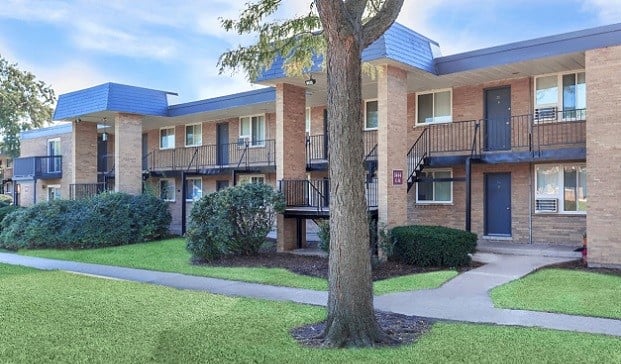
CHICAGO—Luxury rental buildings have become some of the hottest properties in the nation's urban cores, but many of the millennials that could make up a good portion of the renters may feel priced out of this housing. Some operators have gotten creative, and decided to encourage young renters to share apartments by signing leases for individual bedrooms, rather than for whole units, and continue the co-living arrangements they probably had during college.
“We believe that they have already accepted that model as students, and this has helped us stabilize properties faster,” JJ Smith, chief operating officer at CA Ventures, tells GlobeSt.com. “While co-living is a newer strategy for market-rate communities, it's a model we've been using for more than a decade in our off-campus student housing developments.”
Across the Chicago-based firm's portfolio, the share of non-student residents in co-living residences has doubled from less than 2% a few years ago, to 5% today. And non-student residents, including transient corporate workers in search of furnished housing, make up as much as 15% of the tenant mix at the company's co-living properties in urban centers.
Aaron Galvin, owner and managing broker of Luxury Living Chicago Realty, estimates that developers can potentially achieve more aggregate rent on some unit types than they would in a typical market rate apartment. In turn, renters can lease a bedroom for approximately 20% less than what they would pay for a studio in the same building. “This can save hundreds of dollars each month, and these are renters who appreciate the sharing economy,” says Galvin, whose firm recently leased-up “L”, a 120-unit development in Chicago's Logan Square neighborhood that includes 30 co-living bedrooms.
Furthermore, this strategy “helps minimize or even eliminate loss of rent when someone moves out, as a portion of the unit is still generating income,” says Mark Durakovic, principal of Kass Management Services, which manages the “L” community.
The co-living strategy is especially effective in university towns, such as Lincoln, NE, and Madison, WI, with the kind of high tech jobs that keep students there after graduation. CA Student Living, the student housing investment and development division of CA Ventures, recently completed eight luxury student housing communities comprising nearly 4,000 beds across the US. In Lincoln, NE, the company has a new student housing property where young professionals, many of whom work at the international headquarters of Hudl, a software firm, make up about 15% of the renters.
Having that student housing experience is a plus for any operator that wants to experiment with co-living arrangements. Smith says the company surveys prospective renters as if they were students moving into a dorm to ensure they match people with similar backgrounds and interests. “I don't think we will ever see these arrangements make up more than 20% to 30% of the units at any property,” he adds, “but we definitely see it as aiding our lease-ups.”

CHICAGO—Luxury rental buildings have become some of the hottest properties in the nation's urban cores, but many of the millennials that could make up a good portion of the renters may feel priced out of this housing. Some operators have gotten creative, and decided to encourage young renters to share apartments by signing leases for individual bedrooms, rather than for whole units, and continue the co-living arrangements they probably had during college.
“We believe that they have already accepted that model as students, and this has helped us stabilize properties faster,” JJ Smith, chief operating officer at CA Ventures, tells GlobeSt.com. “While co-living is a newer strategy for market-rate communities, it's a model we've been using for more than a decade in our off-campus student housing developments.”
Across the Chicago-based firm's portfolio, the share of non-student residents in co-living residences has doubled from less than 2% a few years ago, to 5% today. And non-student residents, including transient corporate workers in search of furnished housing, make up as much as 15% of the tenant mix at the company's co-living properties in urban centers.
Aaron Galvin, owner and managing broker of Luxury Living Chicago Realty, estimates that developers can potentially achieve more aggregate rent on some unit types than they would in a typical market rate apartment. In turn, renters can lease a bedroom for approximately 20% less than what they would pay for a studio in the same building. “This can save hundreds of dollars each month, and these are renters who appreciate the sharing economy,” says Galvin, whose firm recently leased-up “L”, a 120-unit development in Chicago's Logan Square neighborhood that includes 30 co-living bedrooms.
Furthermore, this strategy “helps minimize or even eliminate loss of rent when someone moves out, as a portion of the unit is still generating income,” says Mark Durakovic, principal of Kass Management Services, which manages the “L” community.
The co-living strategy is especially effective in university towns, such as Lincoln, NE, and Madison, WI, with the kind of high tech jobs that keep students there after graduation. CA Student Living, the student housing investment and development division of CA Ventures, recently completed eight luxury student housing communities comprising nearly 4,000 beds across the US. In Lincoln, NE, the company has a new student housing property where young professionals, many of whom work at the international headquarters of Hudl, a software firm, make up about 15% of the renters.
Having that student housing experience is a plus for any operator that wants to experiment with co-living arrangements. Smith says the company surveys prospective renters as if they were students moving into a dorm to ensure they match people with similar backgrounds and interests. “I don't think we will ever see these arrangements make up more than 20% to 30% of the units at any property,” he adds, “but we definitely see it as aiding our lease-ups.”
© Touchpoint Markets, All Rights Reserved. Request academic re-use from www.copyright.com. All other uses, submit a request to [email protected]. For more inforrmation visit Asset & Logo Licensing.








